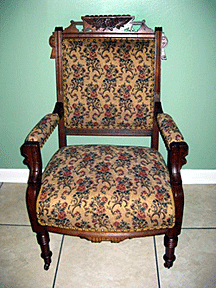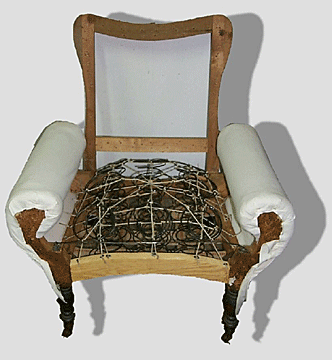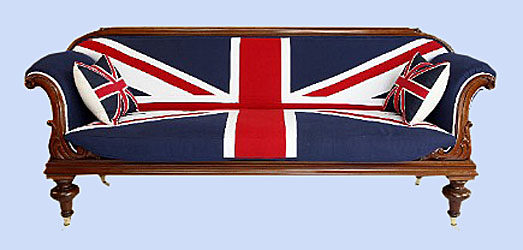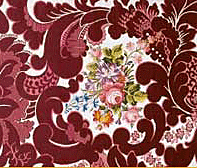|
Bringing New Life to Antique
Upholstered Furniture
by
Bob Brooke
 While
you were out antiquing recently, you noticed an upholstered
Victorian chair that would go perfectly go perfectly in your living
room. But the covering on the chair is in a sad state of affairs.
Most antique chairs have a hardwood frame and most have an eight-way
hand-tied spring foundation. Not sure if you've got sturdy frames?
Lift one up. If it's heavy, there's a greater likelihood of a
quality hardwood frame. If it's lightweight, it's probably made from
soft wood or particle board. While
you were out antiquing recently, you noticed an upholstered
Victorian chair that would go perfectly go perfectly in your living
room. But the covering on the chair is in a sad state of affairs.
Most antique chairs have a hardwood frame and most have an eight-way
hand-tied spring foundation. Not sure if you've got sturdy frames?
Lift one up. If it's heavy, there's a greater likelihood of a
quality hardwood frame. If it's lightweight, it's probably made from
soft wood or particle board.
Can you recover the chairs yourself or will you have to spend
perhaps an additional $500 each to make them useful again? You’ll
decide that later, but for now, you purchase the chairs.
Unlike other antiques, especially those four to six-figure pieces
dating before 1830, most 19th century furniture can still be used.
In fact, restoring a 19th-century piece, particularly a chair, adds
to its value. But where to start.
 Once
you’ve purchased the chairs, and before you do anything to them,
you’ll need to do some research. Today, you not only have mountains
of antiques books with beautiful illustrations to help you, but you
also have the Internet. First, determine the style of your chairs,
then do an image search on Google for them—that’s right, an image
search. Type in the style of your chairs, in this case “Renaissance
Revival,” then click on the “Image” link in the upper left of the
screen. Once
you’ve purchased the chairs, and before you do anything to them,
you’ll need to do some research. Today, you not only have mountains
of antiques books with beautiful illustrations to help you, but you
also have the Internet. First, determine the style of your chairs,
then do an image search on Google for them—that’s right, an image
search. Type in the style of your chairs, in this case “Renaissance
Revival,” then click on the “Image” link in the upper left of the
screen.
Notice the upholstery on all the examples. See if any looks like
what’s on your chairs. Chances are that your chairs have been
recovered several times during their lifetime. Before the 1980s,
most people didn’t care whether the upholstery on their chairs was
authentic or not. But in the last 30 years or so, people have become
more aware of antiques restoration thanks to all the home decorating
shows on cable T.V.

Once you determine the type and style of upholstery that your chairs
originally had, it’s time to begin work. But do you have the
upholstery skills and time necessary to complete the job? If not,
you should plan on sending your chairs to a qualified and
experienced upholsterer. Sure, you can take a continuing education
course in upholstery, but you won’t learn enough to do a good job on
your somewhat valuable antique chairs.
 However,
even if you take your chair to an upholsterer, you can still choose
the fabric, although some upholsterers insist you purchase your
fabric from them. Before you do anything else, measure the seat,
back, sides, and arms of your chairs to see how much fabric you’ll
need. Or have your upholsterer tell you. Be generous since
upholstery requires a bit more fabric than what you see. If you’re
using a patterned fabric, you’ll also need to match the pattern,
which will require more. However,
even if you take your chair to an upholsterer, you can still choose
the fabric, although some upholsterers insist you purchase your
fabric from them. Before you do anything else, measure the seat,
back, sides, and arms of your chairs to see how much fabric you’ll
need. Or have your upholsterer tell you. Be generous since
upholstery requires a bit more fabric than what you see. If you’re
using a patterned fabric, you’ll also need to match the pattern,
which will require more.
When it comes to mid-19th-century upholstery fabric, most people err
on the conservative side. Most upholstery at the time was far from
conservative. In fact, it wasn’t just bold and loud, it was
downright boisterous. Zebra stripes, polka dots, and such were
common. Today, you can find plenty of patterns that approximate
these early designs. Some companies actually make fabrics that
reproduce them, so check carefully. But understand that reproduction
fabrics will cost more—way more, so that could affect your budget
for your chairs.
During the 1960s and 1970s, many people modernized their antique
pieces. Upholsterers can remove modernization, such as tufts,
channeling, and padding to bring your chair back to its original
look. If your piece has its original horsehair padding, you’ll need
to decide if you wish to reuse it or substitute foam padding
instead.
 As for the type and pattern of fabric, you’ll discover that there are
many fabrics available today that either duplicate historic patterns or
approximate them in cloth that’s more durable than the originals.
Whether you choose velvets or bright florals or neoclassic silks, you’ll
be able to restore the upholstery on your chairs to emulate their
original covering. As for the type and pattern of fabric, you’ll discover that there are
many fabrics available today that either duplicate historic patterns or
approximate them in cloth that’s more durable than the originals.
Whether you choose velvets or bright florals or neoclassic silks, you’ll
be able to restore the upholstery on your chairs to emulate their
original covering.
And remember, many Victorian chairs had nearly as much wooden surface
showing as upholstery. If you cannot do the wood restoration yourself,
you’ll have to get someone to do it before you send the chairs to the
upholsterer or you can have the upholsterer do that for you.
When the job is completed, you’ll have a fine example of a pair of
chairs of whatever period that are not only good to look at and
appreciated in value, but comfortable to sit in.
To read
more of my articles, please
visit
my Web site.
<
Back to Caring for Your Collections
Archives
Next Article >
|
